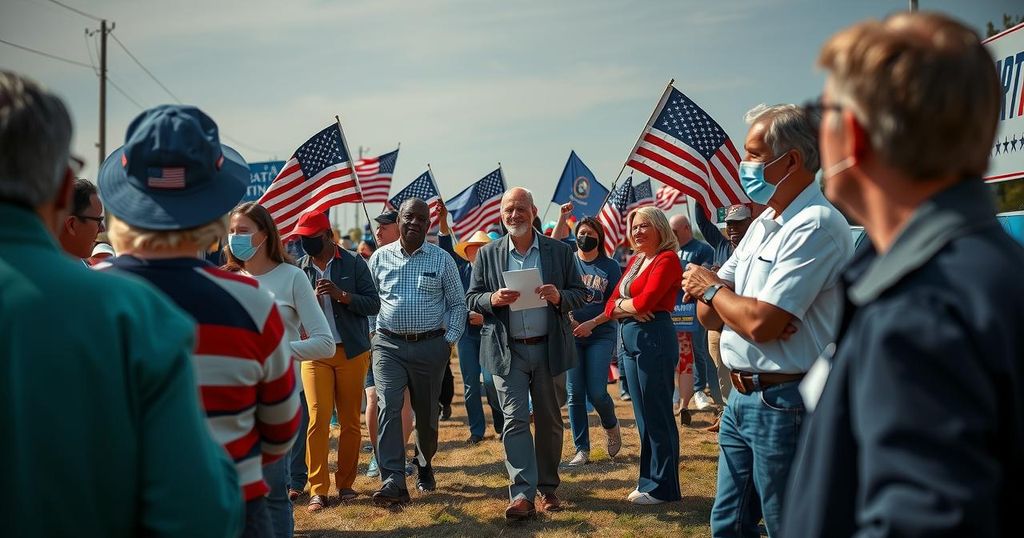Trump and Harris Target Latino Voter Influence in Key Swing States

In the final stretch of the presidential race, both Kamala Harris and Donald Trump are campaigning in critical swing states Arizona and Nevada, focusing on gaining Latino support. Polling suggests that Harris’s support among Hispanic voters has declined compared to 2020, while Trump has made gains. Early voting statistics show a concerning lag in Latino turnout this year, raising implications for both parties as they work to mobilize their respective voter bases.
In the lead-up to the United States presidential election on November 5, both Democratic candidate Kamala Harris and Republican candidate Donald Trump have turned their attention to the crucial swing states of Arizona and Nevada, where Latino voter turnout is anticipated to play a significant role in determining the election outcome. Amid a tightly contested race, both candidates held events on the same day, recognizing the importance of appealing to the Latino community. Trump made a notable detour to Albuquerque, New Mexico, where he engaged with supporters despite the state’s Democratic leanings in previous elections. He expressed a desire to strengthen his connections with the Hispanic community, stating, “I like you very much, and it’s good for my credentials with the Hispanic or Latino community.” Recent polls indicate a troubling trend for Harris, as she garners only 52 percent support among Hispanic voters, a notable decline from the 66 percent support received by President Joe Biden in 2020. Conversely, Trump has made strides with 42 percent of the Hispanic vote, according to a New York Times/Siena poll. The dynamics of the campaign intensified following a controversial incident involving a comedian at Trump’s rally, whose inappropriate jokes about migrants provoked backlash from Latino leaders and celebrities urging support for Harris. As polls remain tightly contested across the nation, both candidates are focusing strategically on key demographics. In their ongoing campaigns, Harris began the day with a rally in Phoenix before moving to Nevada, featuring support from prominent figures such as pop icon Jennifer Lopez and the Mexican rock band Mana. Trump, on the other hand, planned subsequent events in Nevada and Arizona, as both candidates work to convert undecided voters. While the Latino voter demographic is typically Democratic-leaning, they have shown a recent shift towards Republican support, emphasizing the need for engagement from both parties. However, early voting statistics reveal that Hispanic participation is lagging, accounting for just 2 percent of early ballots cast, which is significantly lower than their estimated share of eligible voters, according to the Pew Research Center. There are also emerging trends in early voting related to race and gender. Black voters are exceeding their representation among registered voters, comprising 22 percent of early ballots. Additionally, women have outpaced men in early voting by an 11-point margin of 54 percent to 43 percent. Harris’s campaign has emphasized reproductive rights, and she has been vocal in her criticisms of Trump’s approach to women’s issues, calling his statements “offensive” and highlighting the importance of women’s autonomy.
As both candidates vie for the presidency, the significance of swing states like Arizona and Nevada cannot be understated, particularly given the growing Latino voter population. These states have historically played pivotal roles in elections, and Latino votes could sway the outcome. The current political landscape has seen changing allegiances among Latino voters, with some trends indicating increased support for Republicans. The complexities of voter turnout further complicate the electoral equation, as both parties must mobilize their bases effectively to secure victory. With the election impending, the focus on early voting and demographic trends provides insight into the potential challenges and opportunities each candidate faces. The candidates’ strategies reflect a deep understanding of the evolving political attitudes within the Latino community and the overarching quest for voter engagement in a polarized environment.
In summary, the race for the Latino vote in key swing states like Arizona and Nevada is heating up as the November election approaches. With Kamala Harris and Donald Trump both intensifying their campaign efforts, the shifting allegiances within the Latino community could prove decisive. Polling indicates a drop in support for Harris compared to Biden’s 2020 numbers, while Trump demonstrates newfound traction among Hispanic voters. As both candidates continue their outreach, the challenge remains to energize voter turnout, especially among Hispanics, who historically have lower participation rates. The outcome of this electoral battle could hinge on who successfully mobilizes their supporters and addresses the concerns of essential demographics, including women and Black voters, in a rapidly changing political landscape.
Original Source: www.aljazeera.com







